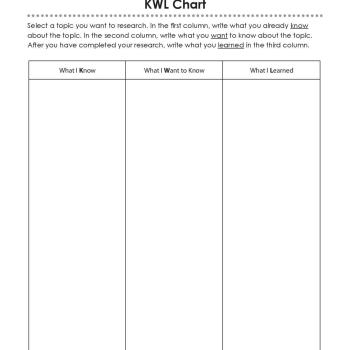Graphic Organizer
K-W-L Chart

Grades
3 - 8
Printout Type
Graphic Organizer
About this printout
This K-W-L Chart, which tracks what a student knows (K), wants to know (W), and has learned (L) about a topic, can be used before, during, and after research projects.
Teaching with this printout
Students in grades 3–8 should engage in various types of research. Using a K-W-L chart, students can prepare to research a topic and use it to track information gathered along the way. This tool will help students confirm what they know about a topic and encourage them to think about how they want to focus their research. Ask students leading questions for each column of the chart, such as, “What do you already ‘know’ about this topic?” “What things do you ‘want’ to learn about the topic, so you can focus your research?” and “What did you ‘learn’ from doing your research?”
More ideas to try
- Have students conduct research about a particular country, an unusual animal, a celestial body, or other content area topic. Ask students to first think about what they know about the selected topic (for example, the poison dart frog) and write it in the first column. Students should then direct their thinking toward the research questions they have about the poison dart frog. These questions are recorded in the second column. Then, as students conduct research, they should add information gathered to the column, showing what was learned. For older students, you may want make a K-W-L-S chart, with the fourth column focusing on what students may “still” want to learn even after completing research.
- Use the K-W-L chart to direct students’ thinking as they begin reading a new chapter book. Show them the title and cover of the book and encourage them to think about what the book might be about. Then ask students to think about what they might already know about the book or the book topic. Encourage them to brainstorm about the events in the book and pose questions about the events or characters. These can be recorded on the chart as a class or individually. As students read the story, instruct them to revisit their questions in the “What I Want to Know” column every few days and answer them in the “What I Learned” column.